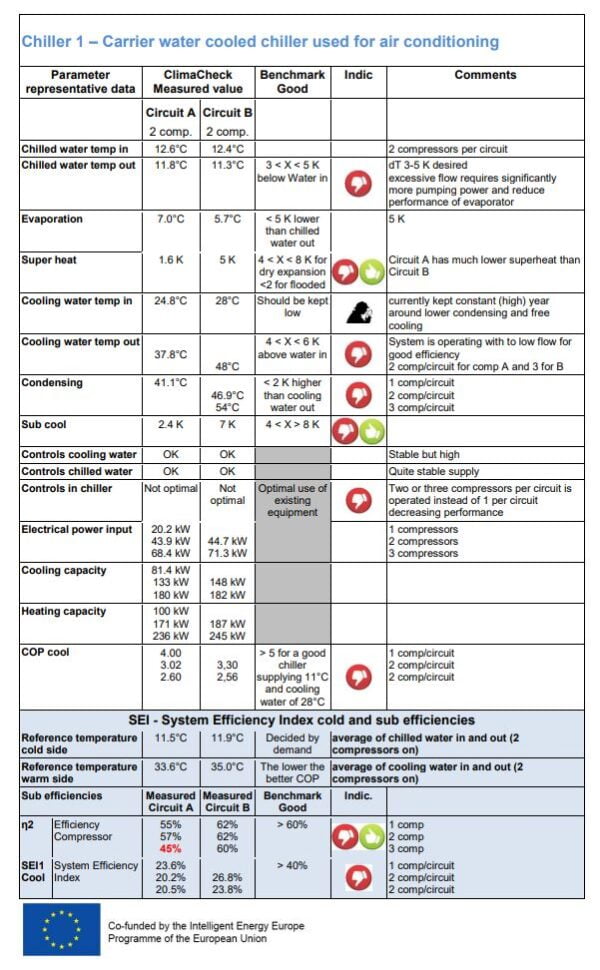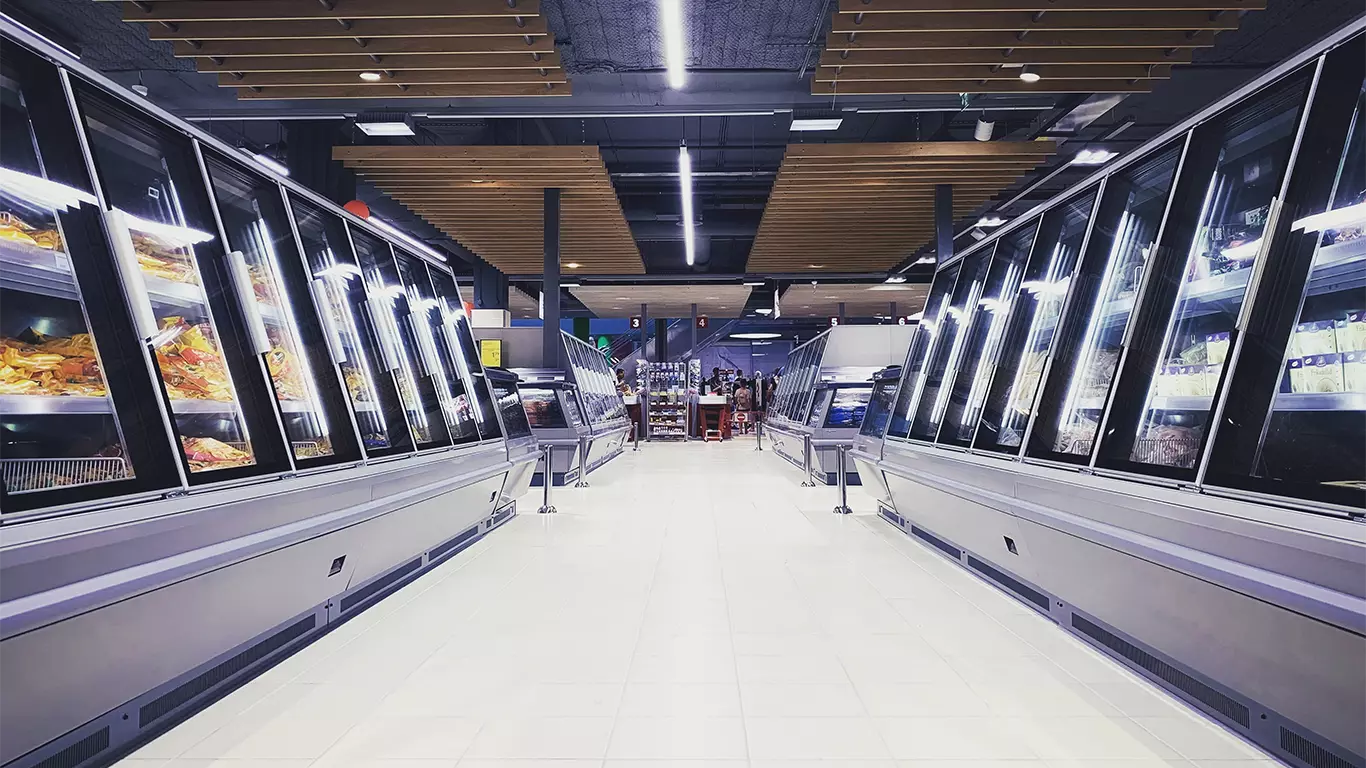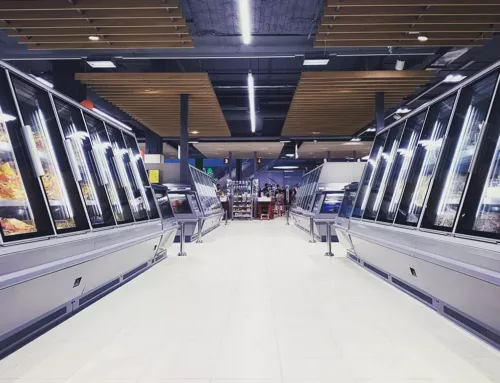Performance and reliability can be significantly improved
– 216 500kWh
Executive summary
The plant is mainly cooled by three independent Chiller system here called Chiller 1, 2 and 3. These are in described in the report and they have based on the measurement period an annual energy consumption for the compressors of 711 000 kWh in the three chillers. Auxiliary loads such as fans and pumps has not been evaluated in detail in this report. When suggested measures are implemented there is also significant cost savings possible by reducing auxiliary energy consumption.
Measurements show that performance and reliability can be significantly improved by low or relatively low cost measurements as listed below. Several of the measures are required to ensure reliability and life time expectancy of the system but will significantly improve the performance as well.
Total savings from low or medium cost investments are estimated to
- 160 000 kWh/year for chiller 1,
- 29 000 kWh/year for Chiller 2
- 27 500 kWh/year for Chiller 3
further reliability and capacity will increase significantly.
Installation of free cooling through a dry cooler offer further savings but at significantly higher cost.
Chiller 1
Chiller 1 is a two circuit water cooled chillers used mainly for air conditioning has an annual energy consumption of 429 000 kWh for compressor energy and a cooling load of approximately 1 330 000 kWh supplied at around 10-12 °C.
The following optimisation opportunities where documented on this chiller
A. This chiller is operating with one compressor with poor efficiency. It is recommended that this is repaired to avoid high energy consumption and risk of
failure. Required for reliability but will also save energy.
B. Low cooling water flow causing high condensing temperatures and poor performance.
C. The control is during base load of 1-2 compressors operating one circuit at the time which result in lower performance than if one compressor on each circuit
was supplying the load. This impact is strongly accentuated by the high temperature difference of cooling water caused by the low cooling water flow.
D. At low ambient temperatures a lower “floating” cooling water temperature would further reduce the operating cost.
E. At ambient below 10 °C free cooling would allow free cooling to be used e.g. cooling without the use of the chiller. In US standard such as ASHRAE 90.1 this
would be a requirement for many plants built today. This saving is not included in estimated saving
The COP during typical two compressor operation during the measurement period is 3.0-3.2 whereas if 1 compressor on each system reach 4.0 and with a more optimal water flow the COP would reach well above 5.0 and significantly higher at low ambient temperatures if cooling water is allowed to follow ambient down to minimum allowed water/condensing temperature for the chiller. This is typically condensing temperatures between 25 and 30°C.
To reset control requires minimal time and can normally be performed during regular maintenance with no investment. After any change of control setting functionality should be validated to ensure reliable operation within manufacturer’s envelope and recommendations.
Defect compressor should be repaired to avoid a high cost failure and this will reduce energy consumption for this compressor with 15-20%.
Cooling water flow need to be increased through a higher capacity pump and a variable speed pump that is set match the flow to the number of compressor in recommended.
The total energy saving for Chiller 1 with these measures implemented will be 40% or approximately 160 000 kWh/year. Table with summary of Chiller 1 performance is shown below at end of executive summary.

Chiller 2
Chiller 2 has a similar design as Chiller 1 but consumption is lower. The total consumption over monitored 5 350 hours is 88 100 kWh corresponding to full year
consumption of 144 930 kWh electrical power to supply approximately 1 180 000 kWh cooling. For details of chiller performance please see summary table below and report.
The following optimisation opportunities where documented on this chiller
A. Low cooling water flow causing high condensing temperatures and poor performance.
B. The control is during base load of 1-2 compressors operating one circuit at the time which result in lower performance than if one compressor on each system
was supplying the predominant load. This impact is strongly accentuated by the high temperature difference of cooling water caused by the low cooling water
flow.
C. At low ambient temperatures a lower “floating” cooling water temperature would further reduce the operating cost.
D. At ambient below 10 °C free cooling would allow free cooling to be used e.g. cooling without the use of the chiller. In US standard such as ASHRAE 90.1 this
would be a requirement for many plants built today.
Implementation of above measures is estimated to save more than 20% of electrical input for this chiller. Corresponding to a saving of 29 000 kWh/year and improved life time expectancy.
Chiller 3
Chiller 3 is an air cooled chiller with two circuits of different capacity with total consumption over monitored 5 400 hours is 121 685 kWh corresponding to full year consumption of 138 000 kWh electrical power for the compressors to supply approximately 460 000 kWh cooling (most of the none measured hours will be less than 3°C when chiller is not required). For details of chiller performance please see summary table below and report.
The following optimisation opportunities where documented on this chiller
A. Correction of refrigerant charge in system would improve capacity and COP drastically and decrease wear of compressors.
A correction of charge is required to ensure reliability of chiller and would result in at least 20% improved performance resulting in a saving 27 500 kWh electrical input.
More information and pictures can be found here
Project details
System: The plant is mainly cooled by three independent Chiller system here called Chiller 1, 2 and 3
Other projects



